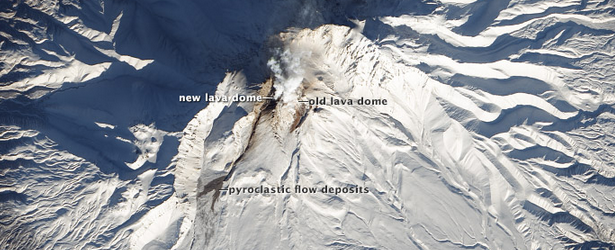Powerful eruption of Shiveluch volcano, Kamchatka

Kamchatkan Shiveluch volcano experienced another strong eruption late on May 12, 2014. Volcanic ash was estimated rising up to 10 km (33 000 ft), Tokyo VAAC reported at 00:02 UTC today.
Emissions lasted the whole UTC night. By 14:15 UTC, volcanic ash was no longer visible on satellite imagery.
According to KVERT's operative report for Shiveluch volcano, issued 02:15 UTC today, the aviation color code of the volcano is still on orange. Distance of ash plume was observed 90 km (56 miles) northwest from the volcano.
KVERT reported that during April 25 – May 2 lava-dome extrusion onto Shiveluch’s SE flank was accompanied by ash explosions, incandescence, hot avalanches, and fumarolic activity.
According to their weekly information release, issued on May 07, 2014, "explosive-extrusive-effusive eruption of the volcano continues. Ash explosions up to 32,800 ft (10 km) a.s.l. could occur at any time. Ongoing activity could affect international and low-flying aircraft.
A growth of the lava dome active continues (a viscous lava flow effuse on southeastern flank), moderate ash explosions, fumarolic activity and incandescence of the dome summit and hot avalanches accompanies this process. Satellite data showed a thermal anomaly over the lava dome all week. " (KVERT)

Image credit: NASA / Landsat 8 – OLI. acquired January 31, 2014.
Geologic summary
The high, isolated massif of Shiveluch volcano (also spelled Sheveluch) rises above the lowlands NNE of the Kliuchevskaya volcano group. The 1300 cu km Shiveluch is one of Kamchatka's largest and most active volcanic structures. The summit of roughly 65,000-year-old Stary Shiveluch is truncated by a broad 9-km-wide late-Pleistocene caldera breached to the south. Many lava domes dot its outer flanks.
The Molodoy Shiveluch lava dome complex was constructed during the Holocene within the large horseshoe-shaped caldera; Holocene lava dome extrusion also took place on the flanks of Stary Shiveluch. At least 60 large eruptions of Shiveluch have occurred during the Holocene, making it the most vigorous andesitic volcano of the Kuril-Kamchatka arc. Widespread tephra layers from these eruptions have provided valuable time markers for dating volcanic events in Kamchatka. Frequent collapses of dome complexes, most recently in 1964, have produced debris avalanches whose deposits cover much of the floor of the breached caldera. (GVP)
Featured image: NASA / Landsat 8 – January 31, 2014.

booyaakaa
https://www.youtube.com/watch?v=br1GrxmMr0s